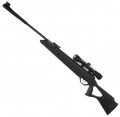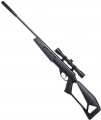Sighting device
The type of sighting device that the rifle is initially equipped with. Note that many models allow the installation of other sights - in addition to the standard sighting devices or to replace them. And optics or a collimator can initially be combined with a mechanical sight (front sight + rear sight), which in such cases plays the role of a spare. However, these features are not available in every rifle, so when choosing, it is best to focus on the type of complete sight.
Nowadays, in addition to the traditional
sighting bar with a front sight, you can find diopter,
optical and
collimator sights in air rifles, and in some models, standard sighting devices are completely
absent. Here are the features of each of these options:
— Sighting bar and front sight. Devices in the form of a front sight and a rear sight, which looks like a horizontal bar with a slot; when aiming, you need to combine these devices so that the front sight is visible exactly in the middle of the slot and flush with its edges. Such sights are extremely popular in modern pneumatics: they are extremely simple, inexpensive, compact and reliable, and do not depend on batteries and are quite resistant to impacts and vibrations. In addition, the front sight with a bar does not limit the view as much as optics or a collimator, and is better suited for shoo
...ting at moving targets. The main disadvantage of this option is that a certain skill is required for effective aiming - after all, you need to control not only the aiming at the target, but also the relative position of the front sight and the slot. On the other hand, this point can also be an advantage - in particular, when learning to shoot: having learned to shoot effectively with such devices, the shooter will feel quite confident with other types of sights. It is also worth noting that the front sight and rear sight do not provide any magnification - this makes it difficult to shoot at small and / or distant targets; however, again, this feature is not always an unambiguous disadvantage.
— Diopter sight. A type of mechanical sighting device (i.e. front sight and rear sight) that uses the diopter principle of operation. The rear sight in such devices is a plate with a small hole through which the shooter looks at the front sight. Such a rear sight is easier to use than a traditional bar with a slot, especially for beginners: even without special skills, the shooter subconsciously chooses a position of the eye in which the front sight will be in the center of the hole (as it should be when aiming). In addition, a small hole gives a slight magnification effect and increases the clarity of the target contours, which is especially important at significant distances. On the other hand, diopters significantly limit the view, are poorly suited for low-light conditions and are easily clogged with various contaminants. Therefore, this type of sight is extremely rarely used in airguns - mainly in powerful long-range rifles, primarily for sporting purposes.
— Optical sight. Traditional optical sights in the form of a "spyglass" with a reticle applied to the shooter's field of view. Initially created for high-precision shooting at long distances, mainly at stationary targets; pneumatics are also used in the same role. True, not every pneumatic rifle with optics is a powerful long-range weapon - there are also relatively "weak" models. But even such pneumatics can be a good training aid in high-precision shooting: a short distance in this case can be compensated for by the small size of the target. On the other hand, optics significantly affect the price of the rifle and require careful handling. Of its features, it is also worth noting that such sights necessarily have a certain magnification; due to this, they allow you to better examine small targets, but at the same time limit the field of view. It is also necessary to take into account that the optics are not well suited for off-hand shooting and require careful insertion: the eye must be located exactly on the optical axis of the sight, otherwise the aiming point may not coincide with the point of impact.
— Collimator sight. The working part of a collimator sight is a glass window onto which a luminous aiming mark is projected using a special optical system — a dot, crosshair, circle with a dot, etc. Sights of this type usually do not have magnification and are intended for shooting at short distances, including at moving targets and offhand. So in use, a collimator is similar to a front sight with a rear sight; and its key advantage is its ease of use: there is no need to combine the front sight and the notch, it is enough to find the aiming mark in the window and point it at the target. At the same time, unlike optics, it is not necessary to keep your eye strictly opposite the center of the sight: the parallax effect (see "Adjusting the parallax") in collimators is very weakly expressed, or even absent altogether. The main disadvantage of this type of sight is that they require batteries to operate; In addition, collimators are significantly more expensive than traditional mechanical sights and also require more careful handling (although they are still less delicate than optics).
It is worth noting that such devices are especially popular in airsoft airguns, such as most AEGs (see "Type"): collimators are great for dynamic combat.
— None. The absence of any sighting devices in the original delivery set — there are only mounts for installing such devices. For more information on the different types of mounts, see below; here we note that such a complete set does not allow you to use the rifle "out of the box", but it does give you the opportunity to choose a sight for it at your own discretion, without relying on the manufacturer's choice. This is especially important if you plan to use optics — nowadays a wide variety of such sights are produced for different tasks and scenarios of use. In fact, most air rifles without a sight are designed specifically for installing optics, although the use of collimators is often also allowed; and in airsoft pneumatics, removable front sights with rear sights are also used.
It is worth noting that spring-piston rifles and gas piston models have a specific double recoil that not every scope can withstand - even if it allows use with powerful firearms. So when looking for optics or a collimator for such pneumatics, you should be especially careful - for it you need to choose scopes originally designed for such rifles.Fuse
The type of safety provided in the design of the rifle.
Recall that the fuse is a device that prevents an unwanted shot. In air rifles, such a device can be
automatic or manual, and in some models it is absent altogether. Here are the features of each option:
— Manual. Fuse, switched on and off exclusively manually, at the will of the shooter. The most common variety — such mechanisms are as simple and inexpensive as possible. They are somewhat less safe than automatic ones (see below) and require more careful attention; however, it is not difficult to develop the skill to properly handle the manual safety. And in multi-shot models, the advantage of manual safety over automatic is that there is no need to make unnecessary actions between shots.
— Automatic. A fuse that, at a certain moment, works automatically, without additional actions on the part of the shooter. Most often, such systems operate in this way: the weapon automatically becomes on the safety lock after the trigger is cocked, and in order to make a shot, you must first turn off the safety lock manually. This provides more safety than in the manual systems described above: if the shooter forgets about the fuse, the shot will not happen anyway. Particularly popular are automatic safety locks in cocked rifles due to a broken barrel (see "Cocking System"): such a mechanism does not allow you to pull the trigger until the shooter has completed relo
...ading. But in other types of pneumatics, this option is rare.
In addition, this category may include systems that are not fuses in the original sense of the word — for example, a mechanism that prevents the bullet from feeding into the chamber of a PCP rifle (see “Type”) if there is already a charge there.
— Is absent. No separate fuse. A similar design is found in two varieties of air rifles. The first is low-cost models with a spring principle of operation (including those with a gas spring; see "Type"). In such models, the fuse is abandoned solely to simplify and reduce the cost of construction; it is worth buying such a rifle only if the future owner knows the safety rules when handling weapons.
The second type of pneumatics without fuses are high-end PCP rifles designed for professional shooters. Similarly, the role of the "fuse" when using such weapons is played exclusively by the skills and experience of the user himself.Barrel length
The working length of the rifle barrel is from the chamber where the bullet is loaded to the muzzle. The shortest barrels found nowadays have a length
of just over 200 mm(and in some AEGs even
less than this value); the longest reach
500 – 600 mm.
There is a stereotype that the muzzle velocity directly depends on the length of the barrel. In firearms, this is true — but not in pneumatics. Firstly, in such rifles, the initial velocity depends on a number of other indicators — pressure, the quality of the barrel treatment, the efficiency of the valves, etc. on the first 20 – 25 cm of the barrel, then the gas pressure drops noticeably. The exception is PCP rifles, in which the longer barrel really makes it easier to achieve high speeds. However, again, so many additional factors affect the final result that models with the same barrel length can differ markedly in initial speed.
The second common stereotype is that a longer barrel improves accuracy and accuracy. This is true in the context that a longer barrel allows for a greater distance between the front and rear sights, making it easier to aim carefully. Technical accuracy does not depend on the length, but on the quality of the barrel processing.
Summing up all of the above, we can say that the length of the barrel for an air rifle is more of a reference than a really significant paramete
...r, and when choosing, it is better to focus on more "close to life" characteristics — first of all, directly claimed muzzle velocity.
